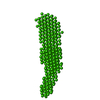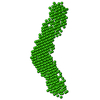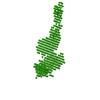+Search query
-Structure paper
| Title | Ca -induced orientation of tandem collagen binding domains from clostridial collagenase ColG permits two opposing functions of collagen fibril formation and retardation. |
|---|---|
| Journal, issue, pages | FEBS J, Vol. 285, Issue 17, Page 3254-3269, Year 2018 |
| Publish date | Aug 20, 2018 |
 Authors Authors | Perry Caviness / Ryan Bauer / Keisuke Tanaka / Katarzyna Janowska / Jeffrey Randall Roeser / Dawn Harter / Jes Sanders / Christopher Ruth / Osamu Matsushita / Joshua Sakon /   |
| PubMed Abstract | To penetrate host tissues, histotoxic clostridia secrete virulence factors including enzymes to hydrolyze extracellular matrix. Clostridium histolyticum, recently renamed as Hathewaya histolytica, ...To penetrate host tissues, histotoxic clostridia secrete virulence factors including enzymes to hydrolyze extracellular matrix. Clostridium histolyticum, recently renamed as Hathewaya histolytica, produces two classes of collagenase (ColG and ColH). The high-speed AFM study showed that ColG collagenase moves unidirectionally to plane collagen fibril and rebundles fibril when stalled . The structural explanation of the roles for the tandem collagen-binding segment (CBDs) is illuminated by its calcium-bound crystal structure at 1.9 Å resolution (R = 15.0%; R = 19.6%). Activation may involve calcium-dependent domain rearrangement supported by both small-angle X-ray scattering and size exclusion chromatography. At pCa ≥ 5 (pCa = -log[Ca ]), the tandem CBD adopts an extended conformation that may facilitate secretion from the bacterium. At pCa ≤ 4, the compact structure seen in the crystal structure is adopted. This arrangement positions the two binding surfaces ~ 55 Å apart, and possibly ushers ColG along tropocollagen molecules that allow for unidirectional movement. A sequential binding mode where tighter binding CBD2 binds first could aid in processivity as well. Switch from processive collagenolysis to fibril rearrangement could be concentration dependent. Collagen fibril formation is retarded at 1 : 1 molar ratio of tandem CBD to collagen. Tandem CBD may help isolate a tropocollagen molecule from a fibril at this ratio. At 0.1 : 1 to 0.5 : 1 molar ratios fibril self-assembly was accelerated. Gain of function as a result of gene duplication of CBD for the M9B enzymes is speculated. The binding and activation modes described here will aid in drug delivery design. ACCESSION CODES: The full atomic coordinates of the tandem CBD and its corresponding structure factor amplitudes have been deposited in the Protein Data Bank (PDB accession code 5IKU). Small-angle X-ray scattering data and corresponding ab initio models have been submitted to the Small Angle Scattering Biological Data Bank (SASBDB). Accession codes CL2, collagenase module 2, CN2, CP2 are assigned to envelopes for tandem CBD at -log[Ca ] (pCa) 3, 4, 5, and 6, respectively. Accession code DC64 was assigned to the complex of polycystic kidney disease-CBD1-CBD2 with mini-collagen. |
 External links External links |  FEBS J / FEBS J /  PubMed:30035850 / PubMed:30035850 /  PubMed Central PubMed Central |
| Methods | SAS (X-ray synchrotron) / X-ray diffraction |
| Resolution | 1.9 Å |
| Structure data |  SASDC44:  SASDC54:  SASDC64:  PDB-5iku: |
| Chemicals |  ChemComp-CA:  ChemComp-HOH: |
| Source |
|
 Keywords Keywords | PROTEIN BINDING / Calcium-binding protein Collagen-binding protein |
 Movie
Movie Controller
Controller Structure viewers
Structure viewers About Yorodumi Papers
About Yorodumi Papers



 hathewaya histolytica (bacteria)
hathewaya histolytica (bacteria)